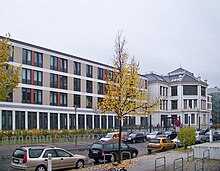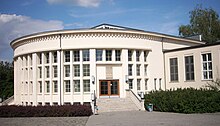University Hospital Leipzig
| University Hospital Leipzig | |
|---|---|
| Sponsorship | Institute of public right |
| place | Leipzig |
| state | Saxony |
| Coordinates | 51 ° 19 '47 " N , 12 ° 23' 19" E |
| Board | Christoph Josten (Medical Director) Robert Jacob (Commercial Director) |
| Care level | Maximum care hospital |
| beds | 1,345 (full inpatient) 106 (partial inpatient) |
| Employee | 4,345 (2019) |
| including doctors | approx. 750 |
| areas of expertise | 29 clinics ( list ) |
| Annual budget | € 457 million (2018) |
| founding | 1415 |
| Website | www.uniklinikum-leipzig.de |
The University Hospital Leipzig is one of the most traditional university hospitals in Germany and with 1,450 beds and over 6000 employees (including the medical faculty) in 29 clinics and polyclinics, eight institutes and seven departments, the largest hospital in Leipzig . The current medical director and dean of the medical faculty is Christoph Josten, the current commercial director is Robert Jacob.
Locations
Most of the facilities at the University Clinic are located on their own premises southeast of the city center in the Zentrum-Südost district - the Medical Quarter or Clinic Quarter on Liebigstrasse. The boundaries are Johannisallee, Sternwartenstrasse, Nürnberger Strasse and Philipp-Rosenthal-Strasse. The clinics can be reached by local public transport operated by LVB and by S-Bahn via the Bayerischer Bahnhof , Ostplatz and Johannisallee stops . Other locations include Semmelweisstrasse and Härtelstrasse.
history
The Medical Faculty of the University of Leipzig was founded in 1415, a few years after the university itself was founded in 1409. As at all European universities, medical knowledge was initially disseminated in a purely theoretical manner. The first step towards modern, scientifically based medicine was taken in 1704 with the establishment of the first anatomical theater (Theatrum anatomicum) by Johann Christian Schamberg . In 1799 the "Institute for Clinical Education" was founded in the Jakobshospital , where patient examinations, surgical demonstrations and dissection exercises took place for the first time. In 1811 Johann Christian August Heinroth was appointed to the world's first chair for "psychological therapy" ( psychiatry ). The current main location of the medical faculty in Liebigstrasse was founded in 1871 by Carl Reinhold August Wunderlich and Carl Thiersch as the “St. Jakob Municipal Hospital”. In 1897, the “Red House”, the landmark of the medical district, was inaugurated. In the period from approx. 1880 to the Second World War, medicine experienced its greatest heyday at the University of Leipzig. With researchers like Paul Flechsig , Carl Ludwig and Wilhelm His, Leipzig was one of the first scientific teaching and work centers in the world at that time . In 1891 Otto Heubner founded the University Children's Clinic. Large parts of the medical district were destroyed during World War II. The first post-war building was opened in 1956 with the Institute for Anatomy; all other institutes were gradually rebuilt. In 1953 the St. Jakob Hospital was transferred to the university. The department for inpatient psychotherapy and psychosomatic medicine , founded in 1953, was one of the first in Germany. Almost all clinics and institutes have been built or completely renovated since 1990. The clinic, which founded the first clinic for cardiovascular surgery in Europe in 1961 , no longer has its own cardiac surgery department, as the private heart center in Leipzig in the Probstheida district has been a university clinic since 1994 , according to a contract between the Free State and Rhön-Klinikum AG . Up to the opening of the Center for Conservative Medicine in November 2008, around 350 million euros had been invested in the Liebigstrasse site. By mid-2009, all departments moved from the old ward block to the new clinic buildings.
The unit built in 1983 was demolished in 2013, and new clinic buildings are to be built on the area that has become free.
Medical treatment
It is a maximum care hospital . It has 1,350 fully inpatient and 101 part inpatient beds. In 2018, 374,020 outpatients and 56,591 inpatients were treated. The turnover in 2018 was 457 million euros. The clinic has several certified treatment units : the largest stroke unit in Saxony (12 beds), a colon cancer center and one of the first skin cancer centers in Germany. The José Carreras Transplant Unit at the Department of Hematology and Internal Oncology is one of the best-known funding measures of the German José Carreras Leukemia Foundation .
research
The main research areas of the university clinic are neurosciences, endocrinology, immunology, molecular oncology and psychosocial medicine. There are collaborations with a number of local research institutes such as the Max Planck Institute for Cognitive and Neurosciences , the Max Planck Institute for Evolutionary Anthropology , the Fraunhofer Institute for Cell Therapy and Immunology , the Helmholtz Center for Environmental Research - UFZ and companies in the Bio City Leipzig .
Blood bank
In 1962 the district institute for blood donation and transfusion was founded, which in 1991 merged with the university blood donation service to form today's institute for transfusion medicine. In 2002 the blood bank brand was introduced to differentiate the institute from other blood donation services. With currently 92 employees, it has two branches in Grünau and Paunsdorf in addition to the institute's location in the clinic district (center) and an acceptance point in the north (Gohlis Park) . There are also around 160 external appointments in the region every year. As the largest university facility for transfusion medicine in Germany, the blood bank collects 55,000 whole blood donations , 12,000 plasma donations and 5,400 platelet donations every year .
Overview of the clinics and institutes
The clinics, institutes and departments of the Leipzig University Hospital are organized in seven departments.
Department of Diagnostics
- Institute of Human Genetics
- Institute for Clinical Immunology
- Institute for Laboratory Medicine , Clinical Chemistry and Molecular Diagnostics
- Institute for Medical Microbiology and Infection Epidemiology
- Institute of Pathology
- Department of Neuropathology
- Institute for Transfusion Medicine
- Institute for Virology
- Institute for Hygiene , Hospital Hygiene and Environmental Medicine
Department of Imaging and Radiation Medicine
- Clinic and Polyclinic for Diagnostic and Interventional Radiology
- Department of Pediatric Radiology
- Department of Neuroradiology
- Clinic and Polyclinic for Nuclear Medicine
- Radiotherapy Clinic and Polyclinic
Department of Internal Medicine, Neurology and Dermatology
- Clinic and Polyclinic for Dermatology , Venereology and Allergology
- Clinic and Polyclinic for Endocrinology , Nephrology and Rheumatology
- Nephrology
- endocrinology
- rheumatology
- Clinic and Polyclinic for Gastroenterology , Hepatology , Infectiology, Pneumology (II)
- Hepatology
- Gastroenterology
- Infectious diseases
- Pulmonology
- Clinic and Polyclinic for Hematology and Cell Therapy, Internal Oncology, Haemostaseology (I)
- Hematology and cell therapy
- Internal oncology
- Hemostaseology
- Clinic and Polyclinic for Cardiology
- Clinic and Polyclinic for Angiology
- Interdisciplinary internal intensive care medicine
- Clinic and Polyclinic for Neurology
- Day clinic for cognitive neurology
Department of Operative Medicine
- Clinic and polyclinic for anesthesiology and intensive therapy
- Clinic and Polyclinic for Neurosurgery
- Clinic and polyclinic for orthopedics , trauma surgery and plastic surgery
- Arthroscopic and special joint surgery / sports injuries
- Endoprosthetics / orthopedics
- Plastic, aesthetic and special hand surgery
- Trauma surgery
- Spinal surgery
- Clinic and Polyclinic for Urology
- Clinic and polyclinic for visceral , transplant , thoracic and vascular surgery
- Visceral surgery
- Obesity and Metabolic Surgery
- Hepatobiliary surgery and visceral transplantation
- Thoracic surgery
- Vascular surgery
- Palliative Medicine Department
Department of Women's and Children's Medicine
- Clinic and Polyclinic for Gynecology - Triersches Institut
- Department of Obstetrics
- Clinic and polyclinic for psychiatry, psychotherapy and psychosomatics of children and adolescents
- Clinic and Polyclinic for Pediatric Surgery
- Clinic and Polyclinic for Pediatric and Adolescent Medicine
- Department of Neonatology
- Department of Pediatric Oncology , Hematology and Hemostaseology
Department of Mental Health
- Clinic and Polyclinic for Psychosomatic Medicine and Psychotherapy
- Clinic and Polyclinic for Psychiatry and Psychotherapy
- Department of Medical Psychology and Medical Sociology
Department of Head and Dentistry
- Clinic and Polyclinic for Ophthalmology
- Clinic and polyclinic for ear, nose and throat medicine
- Polyclinic for Orthodontics
- Polyclinic for children's dentistry and primary prophylaxis
- Polyclinic for tooth preservation and periodontics
- Clinic and polyclinic for oral and maxillofacial surgery
- Clinical and Experimental Oral Medicine Section
- Polyclinic for dental prosthetics and materials science
Organ donation scandal
At the beginning of January 2013 it became known that there had been irregularities in the allocation of donor organs in 2010 and 2011 at the Leipzig clinic. The investigative commission of the German Medical Association and the internal auditing department of the clinic found that the health status of at least 37 of 54 patients had been deliberately shown worse in the context of liver transplants, so that they could be assigned a replacement organ more quickly. In the course of the investigation, the chief physician of transplant surgery and two senior physicians were initially on leave. In July 2015, after the investigation was completed, the Leipzig public prosecutor brought charges against the two senior physicians, as they allegedly manipulated patient files in 2010 and 2011. The investigation against the clinic's chief physician was discontinued unconditionally and no involvement was proven.
Web links
Individual evidence
- ↑ a b c d Universitätsmedizin Leipzig in numbers. Uniklinikum Leipzig, accessed on June 24, 2019 .
- ↑ a b c The university hospital introduces itself. (PDF) Flyer. Retrieved June 24, 2019 .
- ↑ Mario Beck: From for the ward in the Leipziger Volkszeitung , July 21, 2011
- ↑ List of certified stroke units
- ↑ List of certified colon cancer centers. Archived from the original on March 31, 2013 ; accessed on November 29, 2015 .
- ↑ OncoMap. Center search. OnkoZert GmbH, accessed on November 29, 2015 (directory of all centers certified by the German Cancer Society).
- ↑ Newspaper of the University Clinic Leipzig from April 1, 2010 (PDF; 57 kB)
- ↑ Numbers and facts ( Memento from February 1, 2010 in the Internet Archive ) on the website of the Leipzig University Medical Center (accessed on January 21, 2011)
- ↑ Institute for Transfusion Medicine Leipzig - Blood Bank ( page no longer available , search in web archives ) (accessed on January 27, 2011)
- ↑ Christina Berndt: Hour of Lies. In: Süddeutsche Zeitung (online edition). January 2, 2013, accessed on January 2, 2013 : “54 of the 182 liver transplant patients in 2010 and 2011 in Leipzig were reported to have had dialysis; In 37 cases, based on the current state of knowledge, this was simply a lie. In 2012, one in ten patients was cheated. "
- ↑ Christina Berndt: Public prosecutor's office charges former senior physicians with attempted manslaughter. July 24, 2015, accessed March 31, 2020 .








